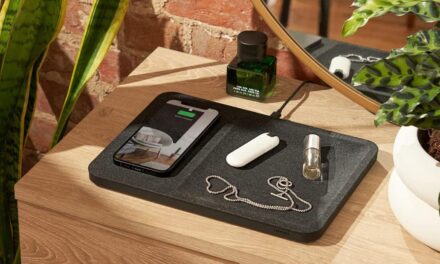
The best electric kettles of 2022

Whether you’re looking to beat the depths of winter’s cold with a hot cuppa or you like to sip warm beverages year-round, electric kettles are a quick, efficient way to heat water without a stove. With most models offering variable heat settings, they’re the best way to get precise brews on pour-over coffees and specialty teas.
To find the best electric kettles, we spent this early winter making ourselves countless cups of tea and pour-over coffee, and in the end we found four great electric kettles to help you brew the perfect cup, whatever your taste and budget.
The best electric kettle overall
The Cuisinart CPK-17 PerfecTemp Cordless Electric Kettle has the best combination of features and performance of the kettles we tested. With six temperature presets optimized for a variety of coffee and tea beverages, a 30-minute keep warm setting, and an ample 1.7L capacity it should serve you well, whatever your beverage.
The best gooseneck electric kettle
Willow & Everett’s Gooseneck Electric Kettle is a steal for only $60. It’s the only kettle we found in this price range that has multiple temperature settings, and it heats water in under 6 minutes. This kettle was also the best-constructed of any gooseneck we tested.
The best budget electric kettle
A simple, no-frills affordable kettle that gets the job done, the Hamilton Beach Glass Electric Tea Kettle heats water faster than any other model we tested.
The best splurge electric kettle
The Fellow Stagg EKG Electric Gooseneck Kettle is for coffee and tea aficionados. Its slow-pour spout is great for precision pours, it offers temperature selection up to a boil in one-degree increments (in degrees Celsius or Fahrenheit) along with a one-hour keep warm setting, and operates more smoothly and quietly than any other kettle we tested.
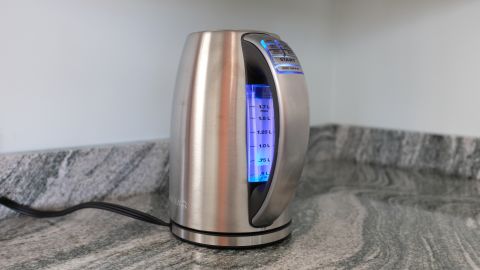
The sleek Cuisinart CPK-17 PerfecTemp Cordless Electric Kettle, is a simple-to-use electric kettle that has the best combination of capacity, features, and control, with useful temperature settings and auditory cues to indicate the beginning and end of its heating cycle––features that other kettles either lacked or didn’t handle as gracefully. This 1.7 liter electric kettle heated up faster than others of similar capacity (and as quickly as many smaller kettles). The only fault we could find is that the Cuisinart is likely not suitable for people hoping to prepare well-extracted pour overs coffees or tea services that require precision pouring, as the spout is wide and stout.
We appreciated the simple, functional design of the Cuisinart far above competitors. When powered on, the control panel (with six temperature settings, a start button, and a keep warm function) illuminates. The capacity measure, gracefully hidden behind its handle, is also illuminated in blue light, so you can easily see how much water has been added. At the beginning and end of each cycle, the Cuisinart kettle beeps, conveniently indicating that warming has begun and finished. The keep-warm setting stays active for 30 minutes. These features — small touches in themselves — add up to a product that feels more useful than the other kettles we tested.
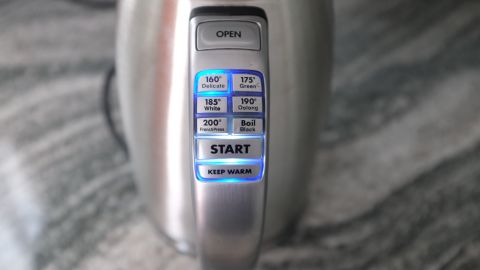
The Cuisinart was one of the fastest electric kettles we tried. It heated to a 212 degree boil at full capacity in a bit under 6 minutes. Many similarly-sized competitors took upwards of ten minutes to heat. Although it seems like this might not be a big deal, the speed is notable in moments when you’re looking for hot water right away. Plus, the larger capacity is great for situations where more people will be using the kettle, whether that be in the office or to serve a house full of tea drinkers. We also found the temperature settings to be accurate overall. When the keep-warm setting was activated, the Cuisinart occasionally heated slightly above the marked temperature setting, but otherwise we had no issues.
Although certainly not a dealbreaker, the Cuisinart’s large, blunt and wide spout may disappoint people who regularly drink pour-over coffees, or otherwise require slow,higher-precision pouring. We had no issues using it to dispense water into mugs generally, but you can’t pour as slowly and carefully as you can with a gooseneck kettle.
The best gooseneck electric kettle: Willow & Everett Gooseneck Electric Kettle ($59.99, amazon.com)
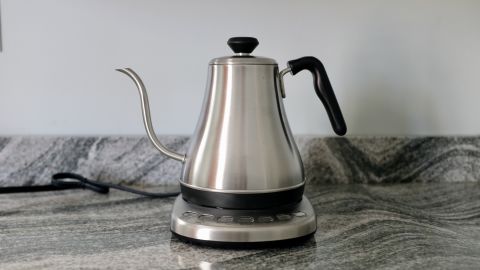
The Willow & Everett Gooseneck Electric Kettle was one of the best gooseneck electric kettles we tested and at around $60 it was easily the best value among them. This kettle was easier to use than many others we tested, with settings that were intuitive and straightforward. The heating element is among the quickest we tried, with one of the highest degrees of accuracy. Plus the design of the heating element and gooseneck themselves are clean, and will look good displayed on a kitchen counter.
The Willow & Everett comes with the features you’d expect from a top performing kettle including five preset heat settings and a keep warm function that maintains your chosen temperature for up to half an hour. Like the Cuisinart, each preset temperature displays a legend describing what beverage it’s best suited for. We preferred the Willow and Everett’s preset temperature settings because they let us prepare drinks without the fussiness of dealing with the more granular settings available on the more customizable kettles such as the Fellow Stagg.
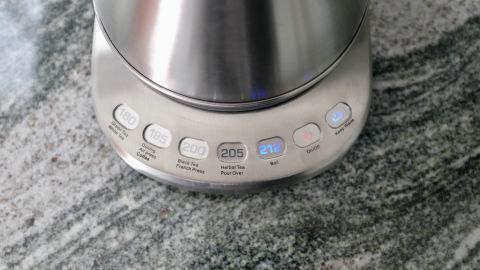
Although with a capacity of only one liter this kettle is smaller than many others we tried, it was also quicker to heat and its temperature settings were more accurate. The Willow and Everett heated the water to within one degree of its stated setting on every test. Additionally, it fully heated the maximum water capacity (1L) in around 5.5 minutes, which was among the quickest we tried, even among other small capacity kettles.
We tested a number of gooseneck kettles for this piece, and among them, the Willow and Everett provided the best combination of features, value and aesthetics. Other models — across the price spectrum — offered far fewer features, didn’t have variable temperature settings and were overall slower to heat.
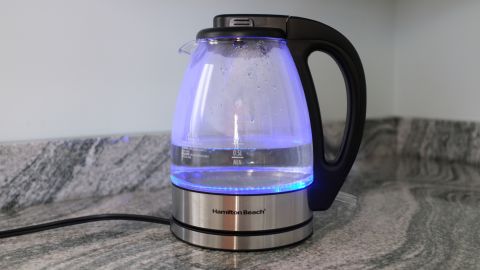
If you’re on a budget or just looking for a kettle to get the job done and don’t need multiple temperature settings, the Hamilton Beach Glass Electric Tea Kettle is an excellent choice. The Hamilton Beach’s main asset is that it heats water more quickly than competitors, but costs half the price of most we tested. It also looks better than most others in the price range, with a clear glass carafe. The Hamilton Beach’s controls are simple: an on-off button, and hinged lid.
The Hamilton Beach only has a one liter capacity, about half that of our main pick from Cuisinart, but heated faster than any other kettle we tested regardless of capacity, taking a hair above 5 minutes to heat a full liter to a boil. The temperature of the kettle is accurate, too, with the water temp measuring in at 212 degrees (water’s boiling point) immediately after shutting off.
The design and quality feel of this kettle was also decent for the price. Its glass construction is attractive, with volume measurements marked up the side of the carafe. The Hamilton Beach has a hinged lid that releases via squeezing two buttons on either side and manually lifting it open. Although the construction of the lid felt a little clunky, we appreciated that it’s integrated and won’t get lost. This carafe is illuminated with a ring of blue lights around the bottom when powered on. The lights go out when the heating cycle has completed in lieu of any audio cues.
The Hamilton Beach has a curved and pointed spout that pours water precisely, dispensing one of the thinnest water streams of any non-gooseneck kettle we tested. While it isn’t quite as easy to control as a gooseneck kettle, it would be suitable for pour-over coffee in a pinch.
Overall, while the overall build and design may not match more expensive kettles, The Hamilton Beach more than makes up for any shortcomings by being one of the most effective kettles we tested, that performs well, and is satisfying to use.
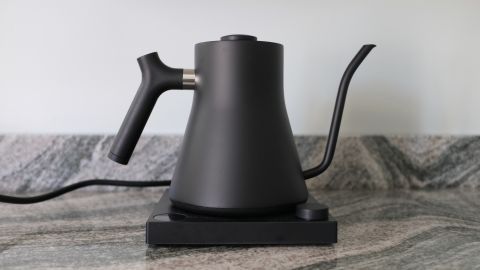
If you’re looking for a top-of-the-line kettle that offers finer-grained control over temperature, quieter performance, and the best looks of anything we tested, the Fellow Stagg EKG Electric Gooseneck Kettle is the best choice. Starting at $150 (some of the fancier finishes cost $20-30 more), this kettle isn’t for most people. But those who are particular about the temperature at which they brew coffee or tea and value the ability to adjust temperature in single-degree increments up to 212 degrees, the Fellow is worth the investment. Along with that adjustability, you get a hold/keep-warm setting and the ability to switch between Celsius and Fahrenheit readings.
The Fellow wasn’t the fastest kettle we tested, but it performed well, heating water to a boil in about 6 minutes. It was also quieter and emitted less steam than every other kettle we tested. The boil seemed to exude a level of calm that no other kettle was able to achieve, and it barely rumbled or shook when it reached the boiling point. While some kettles were very noisy and steamy during their heating process, the Fellow was nearly silent––a sort of jet-black water heating spaceship. It also has a keep-warm feature that remains active for 60 minutes–one of the longest of any we tried.
Of course, a big part of the appeal of this kettle is that its appearance will please design-minded users. The kettle itself comes in nine finishes (ten, if you count their Broccoli green collaboration with Great Jones). Unlike other kettles, the Fellow Stagg EKG sits on a minimalist square heating element marked by two cleanly integrated circles. The leftmost circle is a small digitized screen that displays the temperature settings in the metric of your choosing (Celsius or Fahrenheit). During heating, it shows what temperature the kettle has already heated the water to, and after heating, it displays what temperature the remaining water is at. The circle on the right is a knob that powers the kettle on with a tap, and then spins to adjust to the desired temperature. Along the back of the heating element are two switches: one activates the keep-warm functionality, and the other toggles between temperature metrics (Celsius or Fahrenheit).
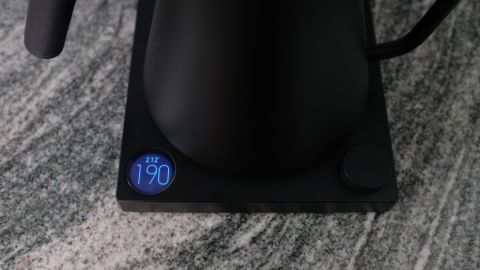
The Fellow Stagg EKG’s handle and spout are placed at slightly different angles from most other gooseneck kettles we tested, but it is pleasant to use and handles comfortably. It poured hot water smoothly at a slow, but even pace, perfectly suited to making pour-over coffee. We had some issues initially with sputtering, but found that keeping the lid’s ventilation holes pointed toward the handle let water flow smoothly.
While we do expect to see more user complaints from an expensive item like this, we noted some users reported that their Fellow Stagg EKG kettles have failed entirely, out of the blue, after only a few months, while others encountered temperature screen glitches or failures. That said, the kettle is covered by a one-year warranty.
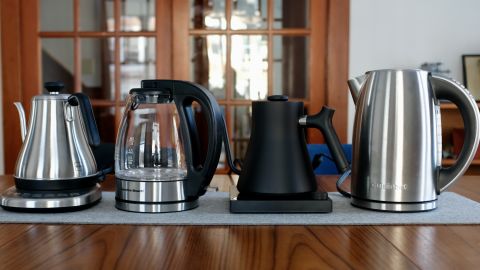
We tested each electric kettle by filling it to its maximum fill-line and setting them to boil (for most kettles we tested this was the only setting). We noted how long each kettle took to boil when filled to capacity, and checked the temperature of the water using a probe thermometer immediately after each heating cycle was completed. For kettles that had multiple temperature settings, we tested each level individually, filling the kettle with cold tap water each time, and measuring the temperature of the water immediately after the heating cycle completed. We also tested the keep warm setting on kettles that had one by waiting around ten minutes after the initial warmup, and periodically checking the temperature of the water with a probe thermometer for consistency. Beyond functionality tests, we also assessed the following:
- Design: We evaluated how the kettles looked, and noted if there were any features or placements that were especially pleasing or frustrating.
- Alerts: Did the kettle have any visual or auditory cues to indicate the warming cycle was complete? How did they compare to other models, and were the cues helpful or just annoying?
- Ease of pouring: For gooseneck kettles, we tested pour over coffee performances over a Kalita Wave for consistency of pouring. For the standard design kettles, we noted how smooth or choppy the water stream was coming from the kettle, and whether it splashed when pouring.
- Ease of cleaning: While this was a non-issue for most kettles we tried, we took note of any design flaws or construction quirks that might make it easier or harder to keep the kettles clean.
Breville Crystal Clear Electric Kettle ($99.5, amazon.com)
We liked the Breville Crystal Clear Electric Kettle and nearly recommended it, but the price is a bit high for such a simplistic kettle, and we have read multiple user complaints about the lid breaking after only a few years of use (plus it’s expensive to replace). That said, if you’re looking for a glass kettle that looks attractive, has simple features, and heats up moderately quickly, the Breville is a great option. We liked that the soft-hinge top pops open silently with the push of a button. And the Breville isn’t fussy to use, with a simple on-off switch below the handle. With a 1-year warranty (and extended warranty purchase options from Breville) this kettle is great for light use, if you aren’t worried about the hinging lid breaking.
OXO Brew Cordless Glass Electric Kettle ($83.99, amazon.com)
We loved the look and features of the OXO Brew Cordless Glass Electric Kettle , but it was the slowest to heat of any we tested, and the kettle is likely too tall for most kitchens. At 11.5” tall, it is clunky under most kitchen cabinets, and some reviewers even report the height makes this kettle unstable. The OXO also heated slower than any other we tested, and it seemed to run a bit hot, often reading 3-5 degrees above the set temperature when its heating cycle was complete.
Kitchen Aid KitchenAid KEK1222PT ($89, amazon.com)
The Kitchen Aid KitchenAid KEK1222PT electric kettle was pleasing to look at in their signature minty green color, but its construction was too irritating to overlook. Like a stovetop kettle, this one has a handle that sweeps across the top, but, annoyingly, it doesn’t hinge to either side for cleaning or filling. So in order to access the kettle’s opening, you’re always battling the stationary handle going across the top. If you can overlook this, the KitchenAid kettle is a reasonable 1.25L, and performed well in our tests, heating water in just under 6 minutes.
Bodum Melior Gooseneck ($50.74, amazon.com)
The Bodum Melior Gooseneck is a good value and looks attractive. It doesn’t have any special features, but it pours smoothly for a great pour-over. We found that despite the handle and lid-pull made from cork the Bodum felt flimsy when handling, like many of the cheaper kettles we tested.
Hario V60 “Buono” Drip Kettle ($79.95, amazon.com)
If you want a solidly made, no-frills gooseneck kettle that holds its own among pricier options, the Hario V60 “Buono” Drip Kettle is a decent choice. It doesn’t have multiple temperature settings or a keep warm function and was solidly average on heating time (around 6.5 minutes), but it is well built and if you don’t mind the basic functions, a good choice.
Capresso H2O Plus Glass Water Kettle ($47.99, originally $59.99; bedbathandbeyond.com)
The Capresso H2O Plus Glass Water Kettle felt poorly made overall. The lid felt like it was about to break off when we opened the kettle. We also noticed that after a few rounds of testing the heating element was already discolored, despite being basically brand new.
Hamilton Beach 40880 Electric Kettle ($32.99, originally $36.99; amazon.com)
We liked the Hamilton Beach 40880 Electric Kettle, but it didn’t stand out in any notable ways. The heating was average and the materials felt fine. If you’ve been considering this kettle over the other Hamilton Beach we recommend, it would be a good alternative option. With a 1.7L capacity, this kettle’s capability goes a bit further with every use.
COSORI Speed-Boil Electric Kettle ($35.99, originally $39.99; amazon.com)
The COSORI Speed-Boil Electric Kettle is decently attractive, but was among the slower to heat up that we tested.
Mueller Ultra Kettle M99S ($34.97, originally $49.99; amazon.com)
Another glass kettle, the Mueller Ultra Kettle M99S took nearly 10 minutes to heat to boiling at full capacity. With a simple design and no other notable features we’d recommend our top picks instead.
Chefman Electric Glass Kettle ($24.88, amazon.com)
Although the tea basket that comes with the Chefman Electric Glass Kettle is novel, it also took more than 9 minutes to fully heat up. This kettle works well, though, and if you want something a bit cheaper than our budget recommendation from Hamilton Beach or need a kettle with greater capacity it might be for you.
Source: https://www.cnn.com/2022/01/21/cnn-underscored/best-electric-kettles/index.html?iid=CNNUnderscoredHPcontainer
















